Services on Demand
Article
Indicators
Related links
-
 Cited by Google
Cited by Google -
 Similars in Google
Similars in Google
Share
Water SA
On-line version ISSN 1816-7950
Print version ISSN 0378-4738
Water SA vol.35 n.2 Pretoria Jan. 2009
Application of a sustainability index for integrated urban water management in Southern African cities: case study comparison – Maputo and Hermanus
SCP De CarvalhoI; KJ CardenII; NP ArmitageII, *
IAfricon (Pty) Ltd., PO Box 494, Cape Town, 8000, South Africa
IIDepartment of Civil Engineering, University of Cape Town, Private Bag X3, Rondebosch 7701, South Africa
ABSTRACT
Poor service provision in developing countries, and particularly the provision of water-related services, present serious challenges to urban development. It is estimated that 300 m. people in Africa do not have access to safe drinking water and 313 m. have limited access to adequate sanitation. The critical situation in the water sector continues to undermine strategies for poverty eradication and retards development. It is possible that the failure in service provision can in part be attributed to an inability by policy makers to address urban water management in a holistic manner. In this study, a systems approach has been adopted to develop a composite index that could be used to assess the potential of a town or city to be sustainable. This index, the Sustainability Index for Integrated Urban Water Management (SIUWM) is composed of 5 components which disaggregate into 20 indicators and ultimately into 64 variables. Two Southern African urban centres, Hermanus and Maputo, were selected as initial case studies to test the applicability and validity of the index and to compare their sustainability index scores. Results of the SIUWM application demonstrate that the index could highlight areas for improvement and ultimately guide appropriate action and policy-making towards better service delivery and improved resource management.
Keywords: sustainability, sustainable development, sustainability indicators, integrated urban water management, systems thinking
Introduction and background
The past two decades have seen global transformation at an unprecedented rate. Population growth, globalisation and urbanisation are all having a significant role in the reshaping of society. World population has risen from 1.7 bn. at the beginning of the 20th century to its current figure of over 6 bn., with population projections indicating that it will reach 9 bn. by 2050 (PRB, 1999). A great majority of the world's population live under extreme poverty and as a consequence the gap between rich and poor has widened restricting progress in many developing countries (Weisbrot, 2002; De Long, 2001). This is particularly the case in Africa where cities are often characterised by low levels of education and employment, high poverty rates, increasing social and economic inequality, mediocre public services and high vulnerability levels. At the local level, poor service provision is an important factor retarding human development. The adequate provision of urban services, and in particular, the three water-related services – water supply, sanitation provision and drainage – are vital in the quest to eradicate poverty and promote economic and social development, and ultimately provide the environment for sustainable development. It has been estimated that 300 m. people in Africa currently do not have access to safe drinking water and 313 m. have limited access to adequate sanitation (CONAGUA & WWC, 2006).
Increasingly the provision of water services is being considered in the light of integrated water resource management (IWRM). IWRM promotes a holistic approach to water resource management that attempts to be socially fair, economically feasible and environmentally sensitive. It calls for more than just the 'triple bottom line' approach to planning and implementation; it insists on the adoption of a systems approach that looks at the integration between human and natural systems and accepts that this will likely force changes in political, social, economic and administrative systems (Lenton, 2004). Urban areas have long been recognised as playing a significant role within IWRM. Integrated urban water management (IUWM) is that component of IWRM that addresses the impact of urban centres on the natural water cycle. It explores, through appropriate management and concerted action, avenues for improved service delivery. It considers the efficient management of water resources including surface water, groundwater and rainwater, as well as methods of desalination and recycling with respect to the collection, treatment, disposal and conservation of water. It also incorporates social and economic considerations geared at improving living conditions and empowering communities to create and manage sustainable livelihoods.
The research described in this paper represents a particular aspect of IUWM, namely an attempt to develop a structured framework for a multi-dimensional assessment of urban water systems in order to define how the objective of sustainability can be achieved. A preliminary composite index, the 'Sustainability Index for Integrated Urban Water Management' (SIUWM) has been developed for specific application to Southern African cities. This paper reviews the results from testing of this index on two urban areas and provides a way forward for continuation of the research.
Ideology and methodology
Sustainability refers to the goal of attaining or maintaining the quality of all life in the long term. Environmental Sustainability refers to that balance which achieves the unimpaired maintenance of environmental sources and sinks (end state/goal). In the context of an urban environment, Gasson (2000) defines a sustainable city (system) as 'an environmentally sustainable city is one which meets its present and future human development objectives without growth in throughput of matters and energy beyond the regenerative and absorptive capacities of its local, national or international hinterland'. This can be expanded to include the following: a sustainable city is one that optimises opportunities for minimising inputs and outputs into the system by adopting practices, processes and technologies that emulate nature and its functions. Sustainability represents an optimal end state; however, this is neither fixed nor constant but is rather time- and space-relevant. Sustainable development is the process through which specific targets are set, actions planned and strategies implemented in order to deliver on current sustainability goals in a manner that is responsive to the earth's capacity to replace 'used' resources and absorb 'generated' wastes, being conscious of the needs of future generations (Goodland and Daly, 1996). Various assessment tools may be used in order to be able to determine whether these goals are being achieved, including simulations, the use of prescribed criteria, and indices.
Simulation exercises are used together with constructed models to enable the understanding of complex systems that are governed by numerous links and interrelations. However, the usefulness of models to measure reality is often compromised by the wide range of data needed to inform a realistic model (Alberti, 1999), which may end up making them too complex and time-consuming to be truly useful. On the other hand, the use of prescribed criteria can result in a measure that is too simplistic to represent the range of interactions in urban systems. The use of indices in such cases can render complex assessments more manageable, depending on the number of indicators and the type of index adopted. Various existing indices were investigated during the course of this research with a view to identifying an appropriate methodology and a core set of indicators and variables to provide input into the proposed SIUWM. These included inter alia; the Environmental Sustainability Index (ESI), the Environmental Performance Index (EPI), the Human Development Index (HDI), the Human Poverty Index, the Water Poverty Index, the Falkenmark Water Stress Index, and the Ecological Footprint.
The first step towards arriving at a methodology for index development involved the definition of the conceptual underpinnings of the sustainability index by way of a system model. Secondly, a clear characterisation of the index was necessary, expressing the purpose and objectives of its development and composition. For the purpose of this research, sustainability was extrapolated from the perspective of the 'triple bottom line' (TBL), which highlights social, environmental and economic dimensions. It is acknowledged, however, that this model has shortcomings. For example, the definition fails to account for institutional aspects within the social dimension, i.e. those that explore human interactions in an environment governed by rules and regulations, cultural beliefs and societal values. In favour of revising the TBL approach, Valentin and Spangenberg (2000) presented a 'prism of sustainability' composed of four dimensions of sustainability, namely: social, economic, environmental and institutional. These are partially correlated with the four categories of capital: man-made, social, natural and human capital, as referred to by Goodland and Daly (1996) in their definition of environmental sustainability. The institutional dimension comprises both political and administrative aspects, which, while intrinsically linked, contribute significantly to the success or failure of urban water management independently of one another. Corruption, poor representation and low levels of democracy are commonly cited problems in the cities of Southern Africa. It is suggested therefore that political aspects present a unique set of issues in the context of this research; hence the call for a separate and 5th dimension of sustainability, the political dimension.
The SIUWM was ultimately designed in a similar manner to the well-recognised ESI developed by the Yale Centre for Environmental Law and Policy (Yale, 2005). The ESI provides a powerful tool for analytically assessing environmental sustainability and as such is a strong policy-guiding instrument. The scale of implementation between the ESI and SIUWM, however, differs considerably. The ESI targets national-level policy whilst the SIUWM aims to improve management of water at sector level, thereby requiring a different approach to indicator development and selection. Nevertheless, there is a commonality of purpose in the two indices with respect to informing on progress towards sustainability, aligning with existing policy and highlighting gaps in legislation.
In order to account for the dimensions of sustainability, mentioned above, the SIUWM was designed using the similar 5 broad components of the ESI:
-
Social/cultural – social fairness and equitable resource distribution
-
Economic – economically sound principles, economic growth and cost returns
-
Environmental – environmental protection and preservation of ecological systems
-
Political – support and international stewardship
-
Institutional/technological – capacity and progress.
The process model shown in Fig. 1 was adapted from the life-cycle assessment (LCA) approach used by Lundin and Morrison (2002) in the development of environmental sustainability indicators for urban water systems. This was linked to the stepwise methodology for the development of composite indices as proposed by Nardo et al. (2005), and comprised the following steps:
1 Building a theoretical framework, which provided the underlying basis for indicator selection and supported the overall index structure. The 5-dimensional view on sustainability was employed, and these 5 dimensions constituted the basic components of the index.
2 Indicator selection (termed 'data selection'), involved the selection of appropriate indicators for the field of research given their relevance to current issues, their appropriateness to the area in question, their scientific and analytical basis plus their ability to effectively represent the issues they are designed for (measurability). This involved an investigation of indices such as the ESI, EPI, WPI, the World Water Assessment Programme (WWAP) set of indicators for South Africa, and the Department of Water Affairs and Forestry (DWAF) key focus areas for water management. Furthermore, a set of 12 selection criteria was compiled and used to screen indicators in accordance with the objectives of this research. Ultimately, 20 indicators were chosen which disaggregated into 64 variables (Table 1).
3 Multivariate analysis was used to assess the overall index structure in view of the various assumptions made in the development process. This entailed a review of the index structure to establish the appropriateness of the indicators, their relevance to the overall assessment of sustainability and the degree of correlation to each other. Indicators measuring the same or similar aspects were either excluded or replaced with more suitable indicator measures.
4 Imputation of missing data involved assessing the step-wise procedure for creating datasets, and in instances where data were missing, determining how to address the issue. The non-availability of data is one of the largest constraints to the success of most assessment exercises; the limited time and resources available resulted in incomplete datasets for this research. Where there were instances of indicators with incomplete data, either substitution or exclusion of variables was adopted.
5 The indicators chosen were both qualitative and quantitative over widely differing ranges. Normalisation involved the conversion of these indicators and/or variables to a comparable form, ensuring commensurability of data. A scale of 0 to 5 was used where the values were based on pre-established reference points or standards; for example, the levels of service for water supply were based on the WHO Guidelines for Access to Water Supply (Howard and Bartram, 2003). Relevant ranges were established for each variable based on their units of measurement, which were then attributed scores on the basis of these ranges. Table 2 provides an example of the kind of standardisation that was applied to the indicator for freshwater resources.
6 Weighting entailed the aggregation of sub-indicators and/or variables according to prioritised issues or statistically determined loads. As a first step, an equal balanced weighting system was applied to all components, indicators and variables to establish an initial base situation. In the absence of a defined and recorded methodology for assigning alternative weights, the following 2 options were considered, namely statistical analysis, and an extensive consultation process which would allow for inputs from various stakeholders and experts. Ultimately, a combination of both approaches was adopted. Firstly, engagement with stakeholders was achieved, and from these meetings key concerns and priorities which demanded greater weightings were established. Secondly, a ranking approach was adopted, in which variables were ranked within their indicator category and then assigned corresponding scores. Five additional sets of weightings were developed in line with the five dimensions of sustainability represented in the index, and here the consultation process became relevant, assisting in highlighting key variables. The intention was to propose various weighting schemes which could then highlight progress along the various dimensions of sustainability, rewarding those areas which perform better with regard to one or more of these dimensions. As will be discussed later, whilst there was some variability due to the differentiated weighting, this variation did not have a big impact on the overall index score for the 2 case-study areas in this study.
7 Aggregation refers to the grouping of indicators according to the underlying conceptual framework. A composite index approach was employed to compute the overall sustainability index score for a particular urban area (SIi), as the sum of all the weighted components (Eq. (1). The standardised value for each variable, Xi, was multiplied by the attributed weight, wxi, to give a value on a scale of 0 to 5. The score for each indicator was then determined from the sum of the variable values multiplied by their respective weightings, expressed as a percentage by multiplying by 100. The scores for the 5 components – and ultimately the SIUWM – were determined in a similar manner.

8 A sensitivity analysis was conducted to assess the robustness of the composite index with regard to the underlying assumptions made in its construction, as well as the 'sensitivity' to changes in such assumptions. Varying the prioritisation of individual variables and indicators was adopted to test whether component and index scores varied considerably in response.
9 Application of the index provided an opportunity to make comparisons to other indices and, where possible, verify and validate certain assumptions and choices made during index development. Assessments of similar index development initiatives were also carried out.
10 Visually appealing and user-friendly tools were developed in an effort to enhance visualisation of the final product and to ensure that the index was well received by its target audience. Findings are presented in a simple and transparent manner, and interpretation of the results displayed to elicit the desired responses. In addition to the Microsoft Excel workbook that was produced, another tool (SI 2007) was developed to provide an improved user interface to enhance the usability and functionality of the index.
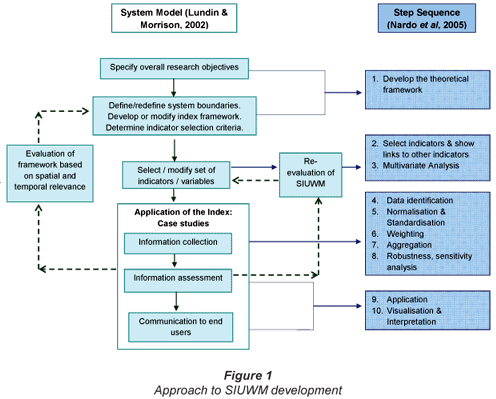
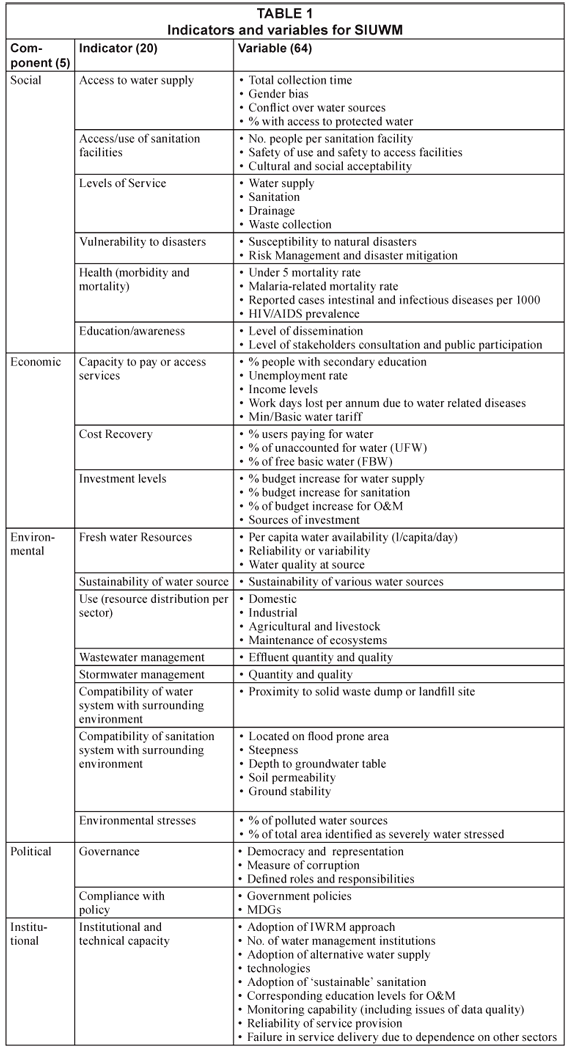
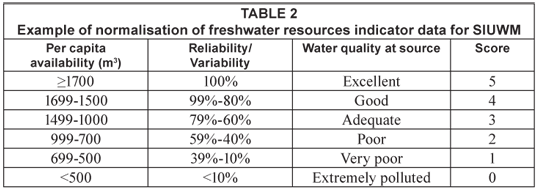
Nardo et al. (2005) propose various statistical methods to address Steps 3, 4, 5, 6 and 8; however, the adoption of such methods was not possible due to the limited number of case studies explored in this research. These steps were nonetheless observed using simpler techniques and qualitative assessments (De Carvalho, 2007) such as using previously adopted selection criteria to screen indicators and variables, and comparison with widely recognised indicator sets
Application of sustainability index
The towns of Hermanus in South Africa and Maputo in Mozambique were selected as initial case studies, mainly based on availability of data and the fact that they represented different socio-economic and environmental scenarios. Maputo faces significant challenges in the provision and maintenance of services to the majority of the population and has limited capacity to monitor and manage resources. Hermanus on the other hand has consistently displayed a commendable performance in water management, including its ability to cope with extreme variations in water demands, through the very effective Greater Hermanus Water Conservation Programme. It therefore offers a useful contrast to the situation in Maputo; but this must be understood in the context of much lower population numbers and densities, as well as significantly higher income and education levels.
Hermanus
Hermanus is a medium-sized coastal town in the Western Cape Province of South Africa (SA), some 100 km south-east of Cape Town. The Greater Hermanus area is comprised of various urbanised suburbs in and around the town of Hermanus and is administered by the Overstrand Municipality, which in turn forms part of the Overberg District Municipality. The climate is typically Mediterranean characterised by hot, dry, windy summers during the months of October to March, and cold, wet winters from April to September. Bulk water supply to the region is largely from the De Bos Dam situated on the Onrus River that flows to the sea a few kilometres to the west of the town centre. There is also some groundwater use, mainly for agriculture and recreational uses (golf course and sports grounds).
The Greater Hermanus area has about 35 000 permanent inhabitants, but this number rises to more than 70 000 during the peak holiday season from November to February (Muller, 2007). Currently, 31% of the households in the area earn below R1 000/month – most notably in the township of Zwelihle that is amongst the poorest and densest of the suburbs of Hermanus (DWAF, 2006). About 95% of the inhabitants of Hermanus have access to basic water and sanitation services (defined as a minimum of 25 ℓ/cap·d within a cartage distance of 200m, and a VIP latrine per household); 70% have full on-site water supply and waterborne sanitation. The remainder have access to either yard taps and septic tanks or communal water supply and VIP latrines. Service provision and management at the municipal level has, however, been significantly strained by population growth and the corresponding demand for both high- and low-income housing.
From an environmental perspective, there is assurance of good water quality, both at source and at the supply end, and in general, payment for services and cost recovery is high in spite of the high poverty levels in some areas. This can largely be attributed to a successful water management programme; the Greater Hermanus Water Conservation Programme (GHWCP), which was created in 1996 in response to increasing pressures on already stressed water resources. The GHWCP is a comprehensive demand management plan based on the application of a progressive block tariff, a so-called 'water-wise' approach, and an informative billing system (Deedat et al., 2007). Reliability of services is guaranteed through an efficient customer service that is responsive to issues such as low pressure, leaks and blockages. In response to ever-increasing water requirements and development concerns, the municipality has undertaken to conduct various studies into the quality and quantity of alternative water resources in the area, e.g. groundwater, effluent from wastewater treatment plants, and desalination. In terms of management, monitoring and compliance with regulations, Hermanus has served as a good example for water management, locally and internationally. It has succeeded in balancing local socio-economic priorities with those at national level as well as with international development standards. This can be said of the provision and quality of services, resource management and water quality monitoring, treatment of wastewaters, implementation of progressive tariffs and good cost recovery, as well as good environmental management and the preservation of valuable ecosystems.
Maputo
Maputo, the capital city of Mozambique, was selected as the 2nd case study. It is situated on the southern tip of the country and is the largest urban centre with an estimated population of 1.4 m. inhabitants (INE, 2007). Although Mozambique is currently one of the poorest countries in the world, it has recently shown consistent growth rates towards slow but progressive socio-economic recovery. Like Hermanus, Maputo is also a popular tourist destination as shown by the increase in population during the holiday months of December and January. The climate is tropical and characterised by months of intense, short-duration rains with the highest intensity in January and February, these also being the hottest months of the year, with average temperatures of 29.7°C.
The main source of water to Maputo City is the Umbelzi River, and the Pequenos Libombos Dam, situated roughly 30 km south of Maputo. This yields an annual volume of 56 x106 m3 of water, distributed mainly in the formalised parts of the city, referred to as District 1. The remaining population, in Districts 2 to 5, are either served by small-scale systems established by the Mozambican Water Utility (AdeM), private providers (known as small-scale independent providers – SSIPs), and/or groundwater resources through private boreholes and wells (FIPAG, 2005). The majority of the population (70%) reside in Districts 2 and 3, where population densities are high and service provision is poor. District 1 (accounting for about 16% of the population) is the only area that is fully serviced in terms of household water supply, waterborne sewerage, and drainage covered by primary, and in places, secondary drainage systems. Cost recovery for the services provided is subject to the capacity of citizens to pay, and this in turn is largely dependent on employment and income levels. An analysis conducted by FIPAG (a consortium of national and international government entities that own and invest in water infrastructure in certain municipalities in Mozambique) indicated that the payment rate for billed water consumption in 2003 was 73%. This does not, however, account for the high unaccounted for water (UFW) rates of over 50%, which place a considerable burden on service provision (FIPAG, 2005).
Results and discussion
There are a number of similarities between Hermanus and Maputo which enable comparisons: both are located on the coast; both are urban centres dominated by urban activities and accommodating high densities, particularly in informal areas; both have experienced significant population growth and socio-economic development in the past decade; and to different degrees both are tourist destinations. The differences far outweigh the similarities though, hence making it difficult to draw significant comparative conclusions. Nevertheless, testing the applicability and relevance of the index at different scales was as much an objective of the research as maintaining comparability. Whilst accounting for the subjectivity of an exercise of this nature, and the need for imputing and/or inferring data, the results obtained nonetheless do not deviate significantly from initial performance assumptions. In the investigation, various weighting schemes were used in the application of the index to the 2 case studies but only the results using equal balanced weighting are reported here for ease of comparison (Table 3, Fig. 2). It was found that the use of different weighting sets resulted in some slight variances in the scores at both indicator and sub-aggregate levels, but that there was little variance in the overall scores at aggregate index level – the maximum variations were 4% for Hermanus and 9% for Maputo.
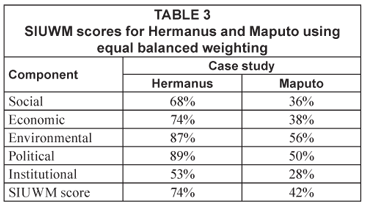
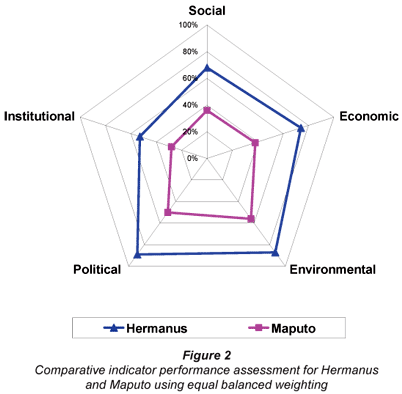
The results show that Hermanus' standing in the sustainability continuum is positive, with an overall performance varying from a lowest score of 72% when adopting an economically biased weighting scheme, to 76% when an institutional weighting bias was introduced. The data in Table 3 highlight the inherent strengths and weaknesses in the general management of urban water in the town, and consequently in the performance across each dimension of sustainability. Single component analysis for Hermanus indicates that 3 dimensions of sustainability are well established, namely political, environmental and economic. In particular, performances in the environmental and political spheres remain consistently high across all weighting applications. Social and institutional concerns, while not as well addressed as the above three, receive satisfactory to moderate scores respectively.
The circumstances in Maputo are somewhat different to those observed in Hermanus. The index scores indicated a less-than-adequate performance with respect to sustainability, ranging from 37% to 46% depending on the weighting scheme adopted. A broad analysis of the results shows that relative strengths lie in the environmental and political dimensions, which achieve scores in the ranges 42% to 58% and 48% to 52% respectively. The institutional, economic and social dimensions on the other hand contribute the least to the overall sustainability of the city, with scores as low as 18%, 34% and 35% respectively.
The large variation in scores for Hermanus and Maputo can be attributed to the following differences between the 2 towns:
-
Levels of service provision; Maputo requires a much more progressive rollout of services and upgrades in infrastructure
-
The relative economic standing, as well as the level of commitment and capacity to engage in environmental preservation
-
The existence – or otherwise – of a supportive political environment to enable implementation of practical protection and mitigation measures; transparency and accountability of management and leadership; and the institutional capacity, management expertise and technological progress to deliver on water service infrastructure requirements.
In an attempt to validate the results from the 2 case studies comparison is made with other well-known indices in Table 4. The available indices tended to address only one of the 5 dimensions of sustainability. National (country) indices had to be used owing to the fact that there are very few indices at the city scale. The HDI was selected for the social dimension; gross domestic product (GDP) was used for economic considerations; and for environmental concerns, both the ESI and the EPI were selected. In the absence of global indices which relate to political and institutional dimensions, results for the following sub-sets of the ESI were used: global stewardship (linked to political leadership), and social and institutional capacity (indicative of institutional and technological capacity).
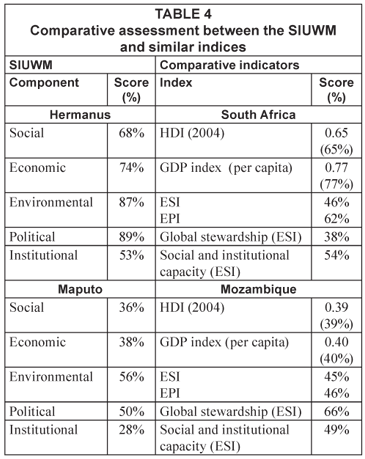
There is good correlation between most of the results obtained for the two pilot cities and their relevant country scores for other indices. There are significant deviations in the environmental dimension scores for the SIUWM and those obtained from the ESI and EPI, but this is explained by the fact that both the ESI and EPI take into account national assessments of a number of resources and resource management strategies that are not represented in the SIUWM. Furthermore, national scores can hide significant regional and local variations, which have been picked up at the more refined assessment scale employed in the SIUWM application. In the case of Hermanus, recent studies have indicated an abundance of groundwater resources at the local level and this has contributed to the overall positive score for environmental management, which is not necessarily the case throughout the country. The political and institutional dimensions also show some discrepancies, and again this could be explained by the differences in indicators selected to assess these components. Where the SIUWM components look to a local level assessment, the indicators extracted from the ESI follow global and national trends in management and policy.
Conclusions
This initiative set out to explore possibilities for improved management and integration of activities in urban water systems to ensure the efficient delivery of services and appropriate accounting of human impacts on the environment. Poor access to efficient water, sanitation and drainage systems, and the socio-economic and environmental effects of this, demand the attention of policy makers, governments, academics, practitioners, businesses and civil society. The assumption made here is that shortcomings in service provision and the management of water resources can largely be attributed to a failure in addressing the interrelatedness and the need for integration in the management of same. The SIUWM attempts to assess the possibility of cities becoming more sustainable by drawing on numerous connections that link the different aspects of urban water management. This assessment has been undertaken with the aim of shaping more sustainable cities of the future by highlighting current unsustainable practices and thus prompting alternative strategies. The research team is still divided regarding the merits of reporting a simple composite index vs. the 5 components. Currently the view is that reporting this figure does not detract from the component analysis and that the simplicity and desirability for a single number could ultimately generate greater awareness for the underlying issues.
Two case studies were selected in order to test the applicability and usefulness of the index in real situations. The results indicated that Hermanus performs well across all dimensions of sustainability, being able to maintain a balance between the needs of society and the preservation of the environment. Such a performance has been supported by a good supply and maintenance of resources, both natural and man-made, including managerial and monitoring capacities. Maputo on the other hand demonstrated a significantly different performance, receiving mediocre to low scores for almost all components. These results were not entirely unexpected; in fact this approximation to the observed reality corroborates the assumption that the development of a sustainability index can identify those areas in urban water management that are unsustainable and by doing so guide the relevant decision-makers towards more sustainable practices. Based on the index results for each case study it was possible to make recommendations for improved performance for all 5 dimensions of sustainability in the 2 urban areas, as well as for improvements to the index itself. In general, it is suggested that greater investments in infrastructure development and resource exploitation and management are required, particularly in Maputo.
In terms of furthering the research and upgrading the index, it is proposed that variations in indicator selection/composition, weighting schemes and methods of aggregation be employed to identify possible variations in scores. Wider application and testing of the index on a variety of settings and scales will be used to determine its applicability and robustness. Furthermore, continued engagement with relevant stakeholders will be used to emphasise the need for greater data collection and the development of regularly updated data banks. This will enable the appropriate use of the SIUWM as an advocacy and management tool at both national and local government level.
Acknowledgements
The research was supported in part by the National Research Foundation of South Africa (NRF).
References
ALBERTI M (1999) Modelling the urban ecosystem: a conceptual framework. Environ. Plann.: Plann. Des. 26 605-630. [ Links ]
CONAGUA & WWC (National Water Commission of Mexico & the World Water Council (2006) 4th World Water Forum: Africa. Local Actions for a global challenge: Africa. [ Links ]
DE CARVALHO S (2007) Sustainability Index for Integrated Urban Water Management (IUWM) in Southern African Cities. M.Sc. Thesis, Department of Civil Engineering, University of Cape Town, Cape Town, South Africa. [ Links ]
DEEDAT H, PAPE J and QOTOLE M (2001) Block Tariffs or Blocked Access? The Greater Hermanus Water Conservation Programme. Occasional Papers, Series #5, Hermanus Municipality, South Africa. [ Links ]
DE LONG BJ (2001) The world's income distribution: turning the corner? http://econ161.berkeley.edu/TotW/world_income_dist.html. [ Links ]
DEPARTMENT OF WATER AFFAIRS AND FORESTRY (DWAF) (2006) Overstrand and Local Municipality Water Services Authority: Status Quo Booklet. Water Services Councillor Induction, Directorate Planning and Information, DWAF, Pretoria, South Africa. [ Links ]
FIPAG (Fundo de Investimento e Património do Abastecimento de Água) (2005) Second National Water Development Project (NWDP II). Projecto de reabilitação das redes de água potável da aglomeração de Maputo. Feasibility Report: Vol 2: Annexes. Prepared by: Seureca and Hydroconseil. [ Links ]
GASSON B (2000) Conceptualising the Ecologically Sustainable City: Frameworks and a Case Study. School of Architecture and Planning, University of Cape Town. [ Links ]
GOODLAND R and DALY H (1996) Environmental sustainability: Universal and non-negotiable. Ecol. Appl. 6 (4) 1002-1017. [ Links ]
HOWARD G and BARTRAM J (2003) Domestic Water Quantity, Service Level and Health. World Health Organisation publication WHO/SDE/WSH/03.02, WHO, Geneva, Switzerland. [ Links ]
INE (Instituto Nacional de Estatística) website (2007) Population statistics and demographics. http://www.ine.gov.mz/. [ Links ]
LENTON R (2004) IWRM Integration needs broad interpretation. A critical view on integrated water resources management. Definition, implementation and linkage to policy reviewed. Stockholm Water Front: A Forum for Global Water Issues 4. http://www.siwi.org. [ Links ]
LUNDIN M and MORRISON G (2002) A lifecycle assessment based procedure for development of environmental sustainability indicators for urban water systems. Urban Water 4 145-152. [ Links ]
MULLER S (2007) Personal communication. Director of Infrastructure and Planning at Hermanus Municipality. Overstrand Municipal Offices, Hermanus, South Africa. [ Links ]
NARDO M, SAISANA M, SALTELLI A, TARANTOLA S, HOFFMAN H and GIOVANNINI E (2005) Handbook on Constructing Composite Indicators: Methodology and User Guide. Organisation for Economic Cooperation and Development (OECD), Statistics Working Paper JT00188147, OECD, France. [ Links ]
POPULATION REFERENCE BUREAU (PRB) (1999) World Population: More than Just Numbers. http://www.prb.org/. [ Links ]
VALENTIN A and SPANGENBERG J (2000) A guide to community sustainability indicators. Environ. Impact Assess. Rev. 20 381-392. www.elsevier.com/locate/eiar. [ Links ]
WEISBROT M (2002) Economists in Denial. August 5, 2002. Washington Post http://www.commondreams.org/views02/0805-02.htm. [ Links ]
YALE CENTER FOR ENVIRONMENTAL LAW AND POLICY (2005) Environmental Sustainability Index: Summary for Policy Makers. Yale University, USA. [ Links ]
This paper was originally presented at the 2008 Water Institute of Southern Africa (WISA) Biennial Conference, Sun City, South Africa, 18-22 May 2008.
* To whom all correspondence should be addressed.
+2721 650 2589; fax: +2721 689 7471;
e-mail: Neil.Armitage@uct.ac.za














